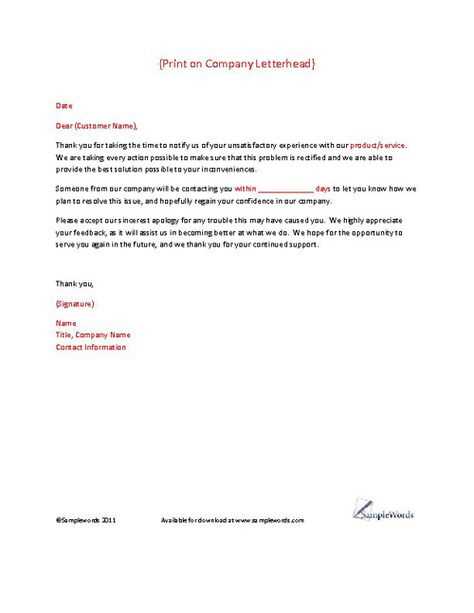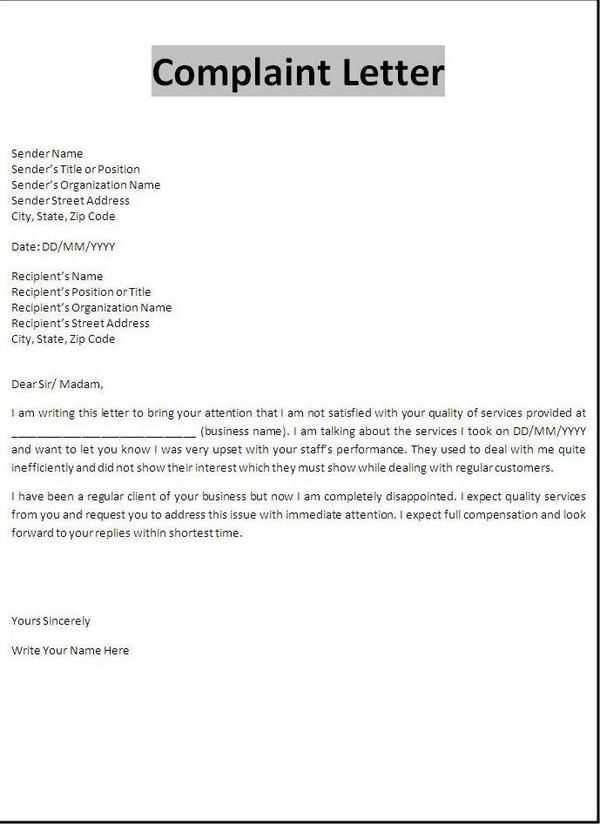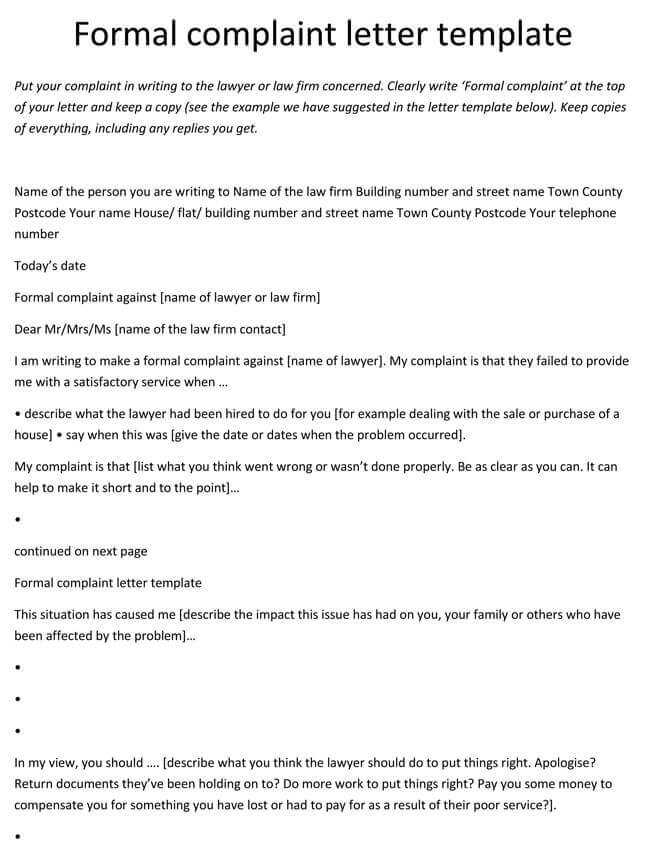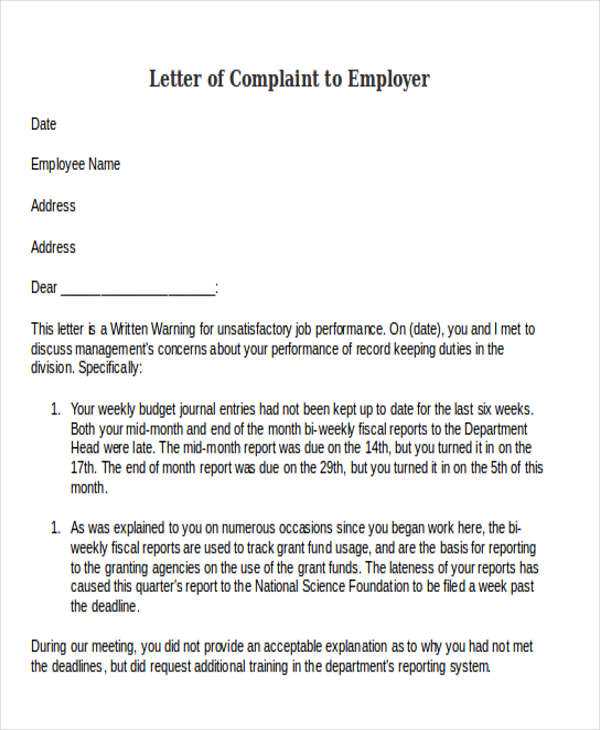Hostile Work Environment Complaint Letter Template

When challenging situations arise in professional settings, it’s important to respond in a way that ensures your concerns are properly communicated. Documenting inappropriate actions and addressing them through formal means can be an effective way to seek resolution and restore a respectful atmosphere. Knowing how to express your feelings clearly and professionally is a crucial part of this process.
In some cases, employees may experience behavior that creates an uncomfortable or toxic atmosphere. Whether it’s unfair treatment, intimidation, or discrimination, addressing these issues through written communication can help create a record that may be useful in resolving the situation. Properly worded communications allow individuals to present their concerns without escalating the conflict unnecessarily.
Understanding the right structure and tone to use when writing such messages can make a significant difference. By following a clear format, individuals can ensure their concerns are taken seriously and handled appropriately, ensuring a smoother resolution process. This guide will provide you with the necessary information to craft an impactful and professional document for such situations.
Understanding Hostile Work Environment Complaints
When negative behaviors impact the professional atmosphere, it is essential to address them in a constructive manner. These situations can create tension and discomfort, making it difficult to perform job duties effectively. Recognizing when the behavior crosses a line and how to address it is an important step in protecting one’s rights and ensuring a productive and respectful space for everyone.
Inappropriate actions that disrupt daily operations or create undue stress for employees are considered serious issues. The affected individual may find it challenging to resolve the situation without assistance, especially when these actions stem from those in positions of power. Understanding the process of addressing such behaviors through formal channels allows employees to stand up for themselves without fear of retaliation.
Addressing these concerns in writing provides a formal record that can help both the individual and the employer. It is essential to document the incident clearly, focusing on the facts and outlining how the situation has impacted one’s ability to perform at their best. When presented correctly, such communication can serve as a catalyst for positive change in the workplace.
Identifying Key Issues in the Workplace
Recognizing the signs of unhealthy behavior in a professional setting is the first step towards resolving the issue. When negative conduct begins to affect your daily activities or emotional well-being, it’s crucial to identify the root cause. These behaviors can manifest in many forms, from aggressive interactions to consistent unfair treatment, all of which can create a difficult atmosphere to navigate.
Understanding what constitutes inappropriate actions and when they start to interfere with your ability to perform tasks is essential. These could include verbal abuse, discriminatory remarks, bullying, or any form of treatment that feels uncomfortable, intimidating, or degrading. By distinguishing these behaviors early on, you are better prepared to address the situation before it escalates further.
Identifying these issues with clarity allows individuals to document specific incidents and present them effectively. Focusing on key moments and details ensures that any formal communication will be based on concrete facts rather than subjective experiences. This clarity is crucial in creating an accurate account of events that can support any actions taken moving forward.
Importance of Documenting Workplace Harassment
Accurate documentation plays a crucial role when addressing any form of improper conduct in a professional setting. When faced with uncomfortable or inappropriate situations, keeping a clear and detailed record of events is essential. This record helps ensure that your concerns are communicated effectively and that there is a clear trail of evidence should further action be needed.
Creating a Reliable Record

When documenting such incidents, it is important to capture specific details such as dates, times, locations, and individuals involved. This objective information will make it easier to present a clear and coherent case. By maintaining an ongoing log, you can ensure that no details are overlooked and can show patterns of behavior that may not be immediately obvious.
Protecting Your Rights
Having thorough documentation also protects your rights as an employee. If the issue escalates or if you need to seek legal advice, your record will serve as a vital tool in supporting your position. This detailed evidence can also encourage a faster and more effective response from your employer, as they can take the situation seriously and investigate accordingly.
How to Keep Accurate Records
Maintaining detailed and accurate records is essential when addressing any situation that involves improper treatment or misconduct. Clear documentation allows individuals to track incidents, providing essential evidence to support claims and make informed decisions. By organizing your records carefully, you ensure that all relevant details are preserved and easily accessible if needed.
Recording Key Details
When documenting an incident, always note the date, time, location, and people involved. Describing the specific actions or words that took place helps create an accurate account. Additionally, keep a record of how the event made you feel and any impact it had on your ability to perform your job. These details are important for painting a full picture of the situation.
Organizing Your Documentation
It is important to store your records in a way that makes them easy to retrieve. Consider using a secure digital document, such as a word processor or spreadsheet, to track incidents over time. For added security, ensure that your records are backed up and stored in a place that cannot be accessed by others. Having organized and accessible documentation will help you respond effectively to any issues that may arise in the future.
Elements of an Effective Complaint Letter
When addressing inappropriate behavior in a professional setting, a well-crafted message is essential to ensure your concerns are taken seriously. An effective letter should be clear, concise, and provide all necessary details to help the recipient understand the issue. Structuring your message properly ensures that the points are communicated without ambiguity, making it easier for your employer to take action.
Clear and Factual Content

Start by stating the specific actions or behaviors that have caused concern. Focus on facts and avoid emotional language. This objective approach allows you to present the situation without exaggeration, making it easier for your employer to assess the facts. Include dates, times, and locations to support your claims, and describe how these actions have affected your daily responsibilities and overall well-being.
Polite and Professional Tone

While the issue at hand may be upsetting, it’s important to maintain a professional tone. Being respectful in your message will help ensure that your concerns are heard without escalating the situation. Avoid using inflammatory or accusatory language, as this could hinder the possibility of resolving the matter effectively. A polite approach increases the likelihood that your employer will respond positively and take the appropriate action.
Essential Components for Clear Communication
Effective communication is key when addressing issues that affect your professional life. To ensure your concerns are understood and taken seriously, it is crucial to organize your message clearly and present the necessary details in a structured manner. Including the right components makes your communication more impactful and allows the recipient to address the matter promptly.
- Be Direct and Specific: Clearly state the issue and avoid unnecessary details that may distract from the main point. Be as specific as possible about the actions or behaviors that need attention.
- Provide Supporting Evidence: Include any facts, such as dates, times, and locations, that help substantiate your claims. This evidence strengthens the credibility of your message.
- State the Impact: Explain how the issue has affected your performance or well-being. This helps the recipient understand the significance of the situation.
- Offer a Suggested Resolution: Provide a reasonable solution or request for action. This shows that you are open to resolving the matter and gives the recipient a clear path to follow.
- Maintain Professional Tone: Even if the situation is difficult, keep the tone respectful and polite. This approach fosters a cooperative atmosphere for resolving the issue.
By following these components, you ensure that your communication is both clear and effective, increasing the likelihood of a positive resolution to the situation. A well-organized message is an essential step in addressing concerns professionally.
How to Address Legal Considerations
When raising concerns about improper conduct in a professional setting, it’s important to understand the legal implications of your actions. Being aware of your rights, understanding relevant laws, and knowing how to proceed can ensure that you are protected and that your actions are legally sound. This section outlines key legal considerations to keep in mind when addressing inappropriate behavior.
Know Your Rights
Before addressing any issue formally, familiarize yourself with the laws that protect employees in your jurisdiction. These laws may vary by location, but they generally cover protections against discrimination, harassment, and retaliation. By understanding these protections, you can better navigate the process and ensure that your actions are within your legal rights.
Documenting for Legal Purposes
Proper documentation is essential not only for internal resolution but also for legal purposes. If the situation escalates, your records may be necessary if you decide to pursue legal action. It’s important to keep accurate, detailed records that can be used as evidence in case of legal proceedings.
| Legal Consideration | Description |
|---|---|
| Non-Retaliation Laws | These laws protect employees from retaliation by their employer for raising concerns about improper behavior or filing a grievance. |
| Discrimination Protections | Laws that protect against discriminatory treatment based on race, gender, age, religion, or disability. |
| Confidentiality Agreements | Ensure that any complaints or disputes are handled confidentially to avoid further harm or legal complications. |
Understanding these legal considerations is vital to addressing issues appropriately. It helps you protect yourself and ensures that your actions are aligned with both company policies and legal standards.
Protecting Your Rights During the Process

When addressing inappropriate behavior in a professional setting, it’s crucial to ensure that your rights are safeguarded throughout the entire process. Taking the right steps at the right time helps protect you from retaliation, ensures fair treatment, and upholds your dignity in the workplace.
- Understand Legal Protections: Familiarize yourself with laws that protect you from retaliation, discrimination, or unfair treatment. Knowing these can help you make informed decisions about your actions.
- Document Everything: Keep a detailed record of all incidents, communications, and actions taken during the process. This documentation serves as evidence in case of disputes and supports your case if necessary.
- Maintain Professionalism: Approach the situation calmly and professionally. Stay focused on the issue at hand, avoiding emotional outbursts that could be used against you later.
- Seek Legal Advice: Consulting with an attorney or labor rights advocate can provide you with expert guidance tailored to your specific situation. Legal professionals can help you understand your options and ensure you’re taking the right steps.
- Know Your Company’s Policies: Understand your employer’s procedures for handling disputes. Adhering to company policies increases the likelihood of a positive outcome and protects your position within the organization.
By following these guidelines, you can navigate the process with confidence while safeguarding your rights. Protecting yourself during this process is essential for ensuring fairness and securing a resolution that reflects your needs and concerns.